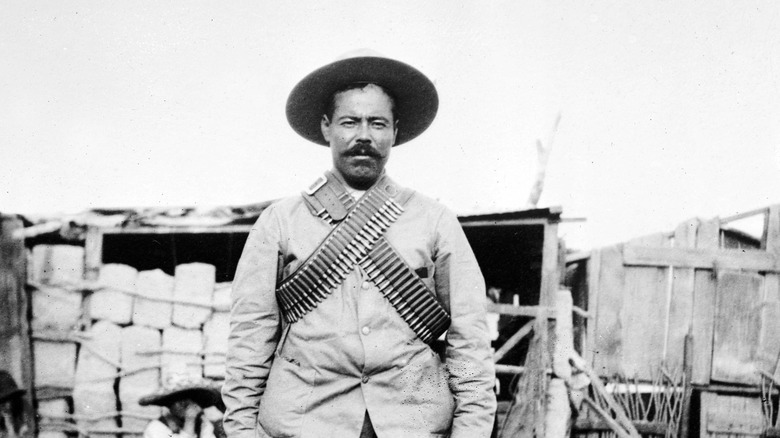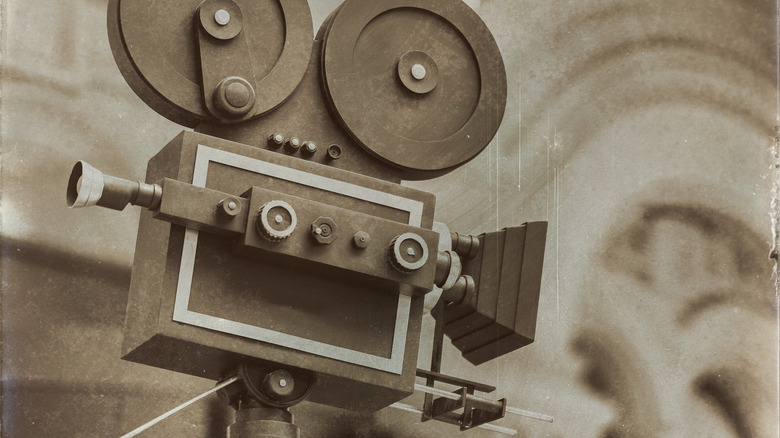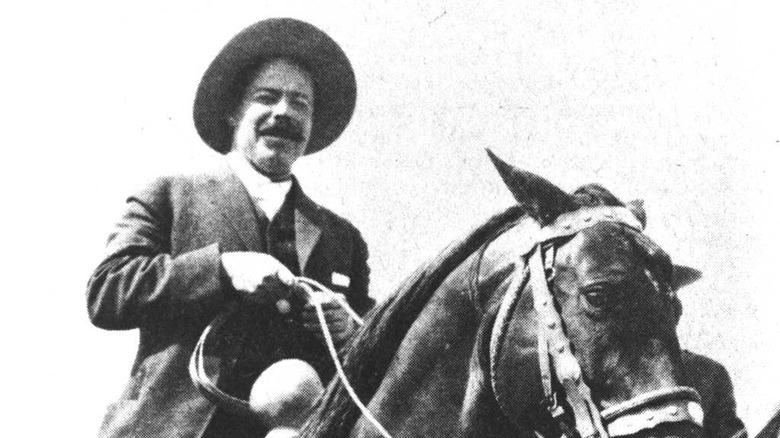The Legendary Lost Biopic Of Pancho Villa
Pancho Villa and his army of 12,000, known as División del Norte (Division of the North) fought hand-to-hand combat against the Federales, the troops of Mexican dictator Victoriano Huerta for control of the stronghold of Torreon in northeastern Mexico. It was early in the 20th century, and amid the whizzing bullets, exploding grenades, dying, and bloodshed, American cameras rolled, capturing it all. Villa, the rebel leader, was on the march towards the capitol. Besides leading his soldiers to victory, just a month earlier he'd signed a film contract with the New York City-based Mutual Film Company for exclusive access to film him and his army, according to the book, "The Life and Times of Pancho Villa."
The Americans had even given the general a nice new uniform to replace his shabby sweater and slouch hat. But the resulting newsreels lacked a certain flair and so the filmmakers decided they could do better and give the American viewing public what they craved: melodrama. The resulting film "The Life of General Villa," tells the story of a man who seeks revenge against two evil Federales who sexually assault his sister and label Villa an outlaw, which only vaguely resembles Villa's biography. The actor Raoul Walsh played the younger Villa (and shot some of the war footage) while the real Villa portrayed himself in other scenes. Mutual filled out the movie with the actual battle footage they'd shot as newsreels.
A new proposition
It all started In early 1914 when Harry E. Aitken, the head of the Mutual Film Company, had a novel idea he believed would be a boon for both himself and Pancho Villa. Aitken sent a film agent into Northern Mexico where Villa and his soldiers were camped out who embedded himself with the rebels for several weeks while the agent hammered out the film contract with the general.
Legends about the film contract have grown over the years that included stipulations that Villa's army only fight during daylight hours since the cameras of the era didn't allow for nighttime shoots and that Villa would reenact battle scenes for the camera. "There was absolutely no mention of reenactment of battle scenes or of Villa providing good lighting," Villa biographer Friedrich Katz told Smithsonian Magazine. "What the contract did specify was that the Mutual Film Company was granted exclusive rights to film Villa's troops in battle and that Villa would receive 20% of all revenues that the films produced."
Pancho Villa film star?
"I am a partner of Gen. Villa," Harry E. Aitken told The New York Times in January 1914 just as the ink was drying on the contract. "It is a new proposition and it has been worrying me a lot all day. How would you feel to be a partner of a man engaged in killing people, and do you suspect that the fact that moving picture machines are in range to immortalize an act of daring or of cruel brutality will have an effect on the warfare itself?" Aitken apparently didn't ponder these thoughts too deeply. He quickly sent in 12 cameramen to cover Villa's march toward Mexico City, per the Ogden Standard. But just a few weeks later Aitken assessed things and decided a fictionalized account of Villa's life would make for a better investment.
The fictionalized film premiered in Manhattan in May 1914. To squeeze out even more profit from the endeavor, Mutual re-edited the film and released it a second time in 1915 under the title "The Outlaw's Revenge." Villa eventually made it to Mexico City but had to flee North after his alliance with Venustiano Carranza broke down. By 1916, Americans had turned against Villa after he raided Columbus, New Mexico, that March, and killed 17 people. Assassins ended his life on July 20, 1923, three years after he'd retired from politics and banditry. The semi-fictional film about Villa has been lost to time with only snippets of the newsreels having been found.


